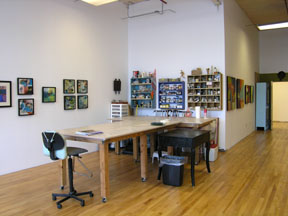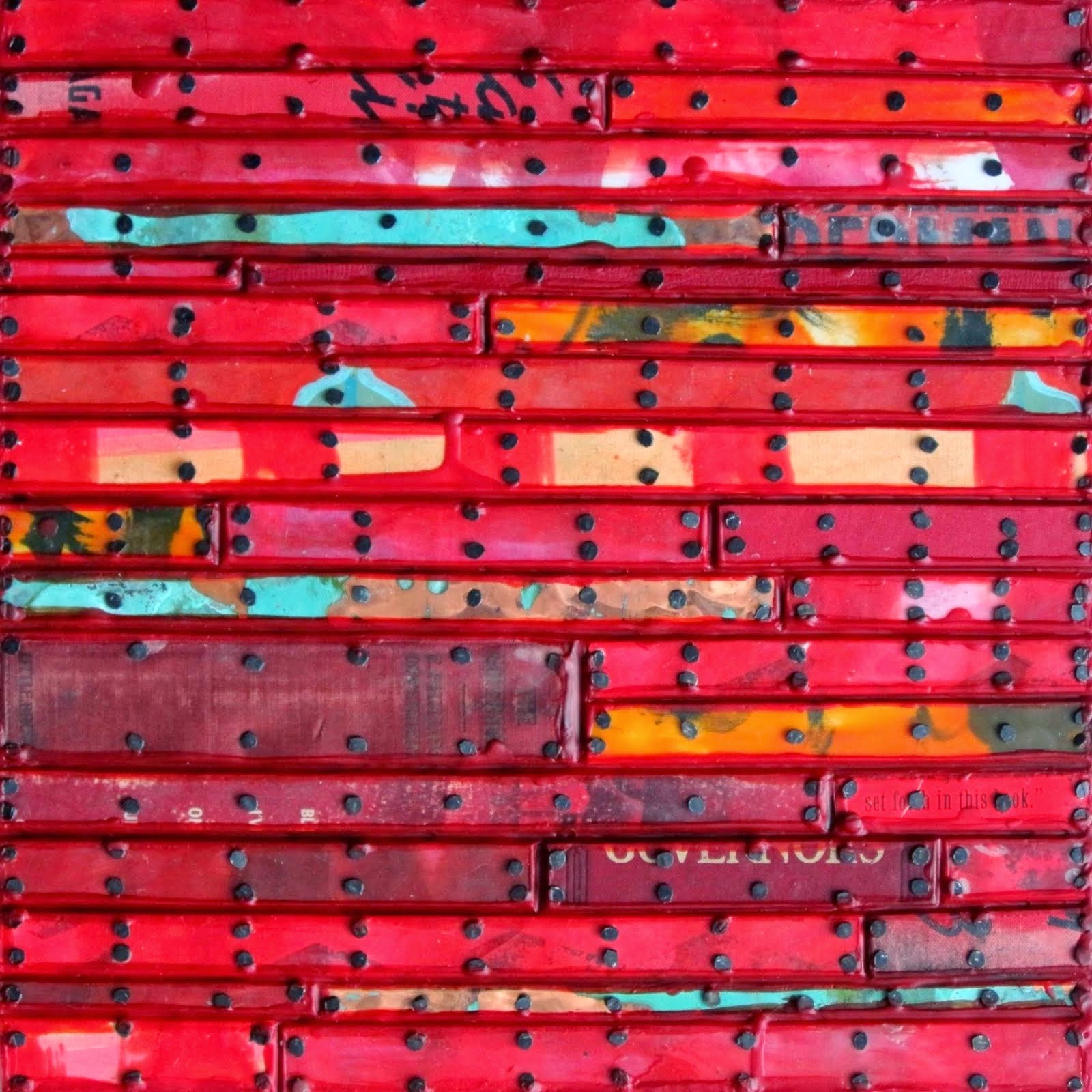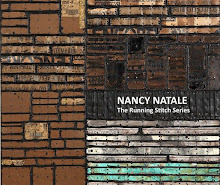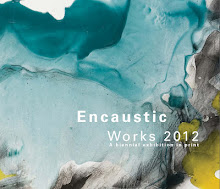 |
| Kim Bernard at the beginning of her mold making workshop |
The week of workshops held after the encaustic conference at the Truro Center for the Arts at Castle Hill (the "post-con workshops") are a great opportunity to pick up some new techniques or skills firsthand from specialists. I was really happy to see that Kim Bernard was doing a one-day workshop on making plaster molds for casting wax and signed up right away.
I do not use either plaster or cast wax in the work I'm making currently, but it never hurts to learn something that may rattle around in your mind for a while and be useful some time in the future. I started out thinking that I was really more interested in the plaster objects than in those made out of wax, but I have to admit that the wax objects are pretty alluring.
 |
| Kim with a big bag of plaster |
Plaster
Before we began making molds, Kim explained about plaster, also referred to as plaster of Paris, but sold as "gypsum plaster" in large paper bags. It can be bought in small sacks or plastic containers in hardwares or home stores, but is much less expensive to buy by the bag. It's important to store it in a dry place as once moisture reaches it, it will harden and become unusable. If you can store it in a sealed plastic bucket, it will probably stay more moisture free.
The way it's mixed is to fill a flexible plastic container about half full with cold water and then add plaster to it by the handful, crumbling each handful into the water to eliminate any lumps.When the dry plaster builds up enough to be visible on the top of the water, you stop adding more and let it sit without stirring or jostling for about five minutes until it sets up. After that you begin slowly stirring it with one hand so you can feel the viscosity change.
 |
| Here Kim has just added the first layer of plaster over the clay object she is molding |
One-Part Molds
We began with the simplest type of mold - just one part - and made on a simple object with no undercuts. For this we used clay to model an uncomplicated shape. (Note that we did not use the artichoke that I brought which was way too complicated even for a two-part mold.)
 |
| As the plaster becomes thicker and thicker, it is smoothed onto the object |
 |
The plaster is built up to about 1" thick over the object and then flattened
on the top so that it will stand flat when it's turned over. This is Kim's lovely mold. |
 |
| This is my awkward-looking mold. |
Once this process is completed, you have to wait for the plaster to finish hardening. It becomes quite warm as it hardens and must cool down before continuing. This took maybe 20 minutes or so.
 |
| Here Kim is showing the inside of the mold after removing the clay from it |
 |
Kim scrubs the mold with a toothbrush to remove traces of clay and
then lets it sit submerged in the water for five minutes or so |
The mold is saturated with water so that the wax is less likely to stick to it and will separate more easily.
 |
Here Kim has positioned and shimmed the mold
so that it lays flat and she has ladled wax medium into it.
(Photo courtesy of April Nomellini.) |
After the wax is ladled in, it is left to cool and will harden from the outside in. You can either let it cool entirely so that it forms a solid object or you can stop the process when the wax shell is 1/8 to 1/4 inch thick by pouring off the excess wax from the middle.
We all completed this process with the objects we formed from clay, making the one-part mold and casting it in wax.
 |
| My one-part mold and the wax cast |
 |
| Our class was held outdoors in "The Shed" |
 |
| A broader, more tilted view |
Two-Part Molds
 |
First part of the clay mold for a banana. At the stem end of
the banana is a funnel-shaped piece of clay that will become a pour spout. |
Once you have made a one-part mold, you can easily move to a two-parter because the process is the same and it's not even twice as hard. This time the clay is shaped around an object, leaving about an inch beyond it and building up a little wall around the edge (see above). A pour spout is made at a good spot for wax to flow into the mold and three or four impressions are made in the clay that will be used for registration. The most important part of the two-part mold is deciding where the line will be where the two parts come together to form the wax object. With a banana that line is pretty easy to decide.
Now here's where I had to call in reinforcements: I spaced out on the next step in the two-part mold and got in touch with
Sherrie Posternak, who had been in the workshop with me. Sherrie kindly filled in the blanks for me and sent me a bunch of great pictures.
 |
| Applying a release agent to the banana (photo courtesy of Sherrie Posternak) |
This is a step I forgot. You have to apply a release agent (liquid dish soap with 1/3 water) so that the plaster doesn't stick to the object you are molding.
 |
| Plaster is added in stages as with the one-part mold - first quite liquid |
 |
The plaster is built up to about one-inch thick over the object
and left to cure until it cools down |
 |
Once it is cool, the clay is removed, exposing the object surrounded by
one side of the plaster mold. |
 |
| The mold is cleaned up with a tool called a "sureform" and the other side is prepared |
 |
| Here's another one of Sherrie's photos showing the mold prepared for receiving plaster |
The photo above shows the first part of the mold and the banana coated with two or three applications of release agent, with the funnel-shaped pour spout remade and in place, with a couple of edges built up with clay and with clay shims underneath so that the mold sits flat on the table.
 |
| Next plaster is applied in stages until the mold is built up to about one-inch thick |
 |
| Here's the two-part mold curing as we wait for it to cool (Sherrie Posternak photo) |
 |
When ready, the mold is cleaned up again with the sureform
(especially the seam edge where the two parts come together) and then
the two parts are carefully pried apart with a bread knife |
The object being cast (the banana) is removed when the two parts of the mold are separated and then the mold is placed in a bucket of water, cleaned up with a toothbrush and soaked if it's being cast right away.
 |
| Here the two-part mold is ready for wax to be added (Sherrie Posternak photo) |
The two parts of the mold are taped together to hold them in place and the mold is placed into a container to hold it upright with the pour spout on top. Wax is ladled into the mold until it reaches the top of the pour spout - it will settle as the wax cools. The wax-filled mold is left to cool until the wax hardens and then the parts are carefully separated. The seam edge and the pour spout edge are cleaned up with clay tools or a knife and repaired with small additional amounts of wax.
This sounds like a lot of work, but the molds can be reused to cast multiple wax objects.
Apparently neither Sherrie, April nor I took a photo of the cast banana. It may not have been cooled enough to remove from the mold by the time the workshop ended, or maybe we were all distracted by the face casting which went on at about the same time the two-part mold was being filled.
This was a good class with a lot of info and I will use this post to follow the process if and when I use it.
A Final Note
Because my two-part mold was not ready to take apart at the end of the workshop and I was hurrying to clean up so I could get in to hear Joanne's talk about Wax in the Galleries, I never separated the two parts of my mold and removed the banana.
 |
| My two-part banana mold |
Here is a photo I took of it in the studio today. It's really not as green as this looks, but I think the gases being emitted from the decaying banana are forcing the two sections apart. Tomorrow I'll try separating it, but I may just have to toss it if it's too nasty. Oh, the travails of making art.
Many thanks to
April Nomellini and
Sherrie Posternak for providing photos and info.




























































































